In the evolving landscape of diabetes management, choosing between different diabetes injections can have a significant impact on long-term glycemic control. Among the most discussed options are Soliqua and Lantus—both of which contain insulin glargine, yet differ in formulation, action, and outcomes. This article offers a comprehensive insulin comparison, explaining the key differences between Soliqua and Lantus to support informed decision-making in clinical practice and personal diabetes care.

Soliqua and Lantus: Core Definitions
What Is Lantus?
Lantus is a long-acting basal insulin analog (insulin glargine 100 units/mL) designed to provide consistent blood sugar control over 24 hours. It is typically administered once daily and is used in both type 1 and type 2 diabetes.
What Is Soliqua?
Soliqua is a combination of insulin glargine (100 units/mL) and lixisenatide (a GLP-1 receptor agonist). This injectable medication is used exclusively for adults with type 2 diabetes, particularly those who have not achieved glycemic targets using basal insulin or oral medications alone.
Mechanism of Action: How Each Medication Works
| Component | Lantus | Soliqua |
|---|---|---|
| Insulin Glargine | ✓ | ✓ |
| GLP-1 Receptor Agonist (Lixisenatide) | ✗ | ✓ |
Lantus
-
Provides a steady release of insulin over 24 hours
-
Reduces hepatic glucose output
-
Promotes glucose uptake in peripheral tissues
-
Used as the foundation of basal-bolus regimens
Soliqua
-
Combines the basal insulin effects of Lantus with the incretin-based benefits of lixisenatide
-
Enhances postprandial insulin secretion
-
Slows gastric emptying, controlling appetite and glucose spikes
-
Reduces glucagon secretion after meals
The GLP-1 component makes Soliqua more comprehensive in targeting both fasting and post-meal glucose levels.
Efficacy: Which Controls Blood Sugar Better?
Lantus
-
Effective in lowering fasting blood glucose
-
Works best when combined with mealtime insulin or oral medications
-
HbA1c reductions typically range from 1% to 1.5%
Soliqua
-
Superior at managing both fasting and postprandial glucose
-
Offers greater HbA1c reduction than Lantus alone (up to 2% in some trials)
-
Fewer daily injections required compared to multi-drug regimens
Clinical trials (e.g., LixiLan-L) show Soliqua achieves tighter glycemic control than basal insulin alone, especially in patients transitioning from oral agents or high-dose Lantus.
Dosage and Administration
| Attribute | Lantus | Soliqua |
|---|---|---|
| Frequency | Once daily | Once daily |
| Timing | Same time daily | Within 1 hour before the first meal |
| Titration | Based on glucose trends | Starts at 15–30 units based on prior insulin use |
| Delivery Device | SoloStar pen | SoloStar pen |
Both are delivered via a pre-filled pen, but Soliqua includes two agents, so dosing must follow specific conversion guidelines to prevent under- or overdosing.
Side Effects and Safety Profiles
Lantus Side Effects
-
Hypoglycemia (especially when used with other insulin or sulfonylureas)
-
Injection site irritation
-
Rare: lipodystrophy, insulin resistance over time
Soliqua Side Effects
-
Milder hypoglycemia risk than Lantus due to GLP-1 component
-
Gastrointestinal effects: nausea, vomiting, diarrhea
-
Possible appetite suppression and weight loss
-
Rare but serious: pancreatitis, kidney function changes, allergic reactions
The GLP-1 component in Soliqua tends to reduce appetite, promoting a more favorable metabolic profile for overweight patients.
Suitability for Different Patient Profiles
| Criteria | Lantus | Soliqua |
|---|---|---|
| Type 1 Diabetes | ✓ | ✗ |
| Type 2 Diabetes | ✓ | ✓ |
| Needs Mealtime Coverage | ✗ (Requires additional insulin) | ✓ (via GLP-1 action) |
| Overweight Patients | May cause weight gain | Often weight neutral or reducing |
| Simpler Regimen Desired | ✓ | ✓ (with dual benefit) |
| GI Sensitivity | Preferred | Use with caution |
Cost and Insurance Coverage
-
Lantus is typically covered under most insurance plans and has generic alternatives (e.g., Basaglar)
-
Soliqua is newer, with limited generic availability, but many providers offer co-pay cards or savings programs
Patients should check with their insurance to evaluate tier placement and out-of-pocket costs for both medications.
Summary: Soliqua vs Lantus—Which Is Right for You?
| Feature | Winner |
|---|---|
| HbA1c Reduction | Soliqua |
| Simplicity | Tie |
| Side Effect Profile | Soliqua (fewer hypoglycemic events) |
| Weight Impact | Soliqua (potential for loss) |
| Flexibility in Type 1 | Lantus |
| Cost & Availability | Lantus |
Soliqua provides an enhanced therapeutic option for type 2 diabetes patients who need tighter control without complicating their regimen with multiple medications. It addresses both fasting and postprandial glucose more effectively than Lantus alone. However, for patients requiring strict basal insulin therapy, particularly in type 1 diabetes, Lantus remains a reliable standard.




